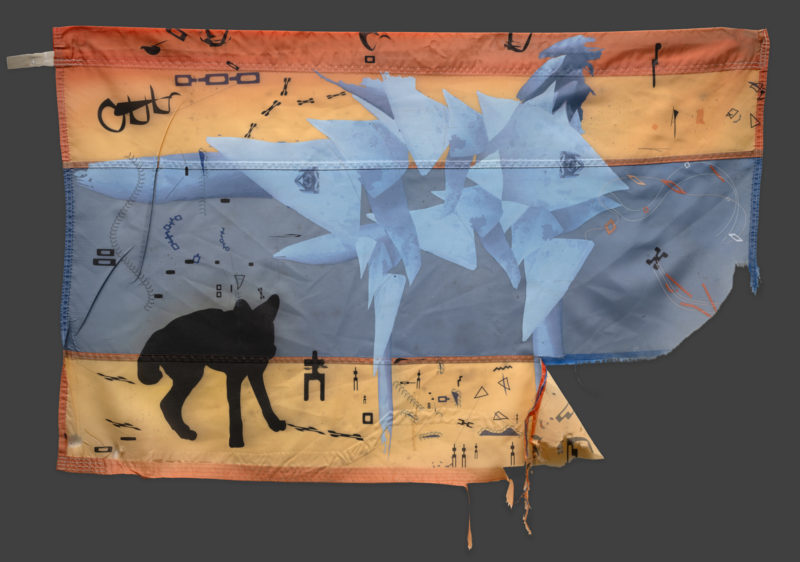
Believing is Not Knowing, 2022
Acrylic on beacon flags used by humanitarian aid group Water Stations
29.5 x 47 inches
unique
Galindo’s Flag works are printed directly onto a group of faded, weathered flags found at the border. Provided to the project by the humanitarian citizen organization Water Stations, these discarded flags were once used to indicate the presence of water tanks placed in the Calexico desert. The surface of each image is traversed by one of Galindo’s signature musical scores, printed in a variety of unique systems of notation that recall the graphic scores of John Cage, Cornelius Cardew, and Karlheinz Stockhausen. Each work vibrates at its own distinctive visual frequency: some are crisply printed with straightforward, rebus-like instructions for a performance; in others, abstractions of line and color approach the playful improvisations of a Joan Miro painting. Galindo’s practice often incorporates playable instruments he has fabricated from objects found at the border. Here, too, he uses the rhythms and patterns of music — as filtered through various inventive modes of visual representation – to elegantly summon a living history from that which has been discarded and forgotten. – Nick Stone
Acrylic on beacon flags used by humanitarian aid group Water Stations
29.5 x 47 inches
unique
Galindo’s Flag works are printed directly onto a group of faded, weathered flags found at the border. Provided to the project by the humanitarian citizen organization Water Stations, these discarded flags were once used to indicate the presence of water tanks placed in the Calexico desert. The surface of each image is traversed by one of Galindo’s signature musical scores, printed in a variety of unique systems of notation that recall the graphic scores of John Cage, Cornelius Cardew, and Karlheinz Stockhausen. Each work vibrates at its own distinctive visual frequency: some are crisply printed with straightforward, rebus-like instructions for a performance; in others, abstractions of line and color approach the playful improvisations of a Joan Miro painting. Galindo’s practice often incorporates playable instruments he has fabricated from objects found at the border. Here, too, he uses the rhythms and patterns of music — as filtered through various inventive modes of visual representation – to elegantly summon a living history from that which has been discarded and forgotten. – Nick Stone
show prices
Prices and availability are subject to change without notice.The copyright of all art images belongs to the individual artists and Magnolia Editions, Inc.
©2003-2025 Magnolia Editions, Inc. All rights reserved. contact us
